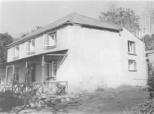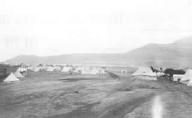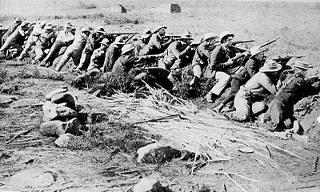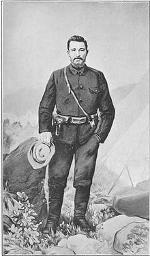
|
Unbanned Bible Publications |
|
Defending God’s Truth in Church Doctrine and Political History – Renette Vermeulen |
|
However, even these very conservative figures do not fit into British statistics. For instance, officially, the Irene camp contained a “mere” 5,400 people, according to the plaque at the Irene concentration camp memorial garden. The number of people in the Turffontein camp is estimated to have been 5,000 — which the British strongly denied. Official statistics or even estimations of interned people, deaths, and graves in these camps are vastly “unknown.” Even the official statistics of the old apartheid regime greatly underestimated the deaths in these camps among whites, (while shamefully ignoring the Africans,) and placed them at 27,837 — 4,177 women and 22,074 children under 16 years of age. So, even if this could be correct, what happened to the children above 16 years of age and to the old men that were also interned with them? And what happened to the children under and above sixteen that went on commando with their fathers, were captured, and imprisoned in concentration camps at home and abroad?
According to statistics, the “approximate’” death rate in African and Afrikaner camps was an “estimated” 344 per thousand and higher. Thus, the “approximate” death rate among the vastly underestimated number of 340,000 Africans and Afrikaners, (10 people per 34,000 scorched farms ,) could not have been less than 116,960 — an overall average of 34.4%. So, where did the old Afrikaner government get less than 30,000 whites — and where do some sources now get only 20,000 blacks that were murdered in the camps? These low numbers are ludicrous! And if they really have proof of graves that might account for these low numbers, where did all the other corpses go? The reality is even worse according to Reader’s Digest’s books. “The worst month for deaths in Afrikaner camps was October 1901, with 401 per 1,000 in the Free State...” In December 1901, the death rate for Africans rose to 436 per 1,000.” “Infant deaths were 629 per thousand!” ‘St. Helena 15.55 South 5.4 West’ wrote, “The death rate in the camps that held women, children and old men was 34%, with 87% at the Kroonstad camp.” These numbers exclude the numbers of deaths among an “estimated” 56,457 prisoners of war in British colonies at home and overseas. Other sources say 28,000 Boer men were captured, (what about the boys among them that went on commando] and 25,630 were sent overseas. I ask again: how can it be coincidence that Britain botched the statistics this way? Of the captured POWS, an “estimated” 12%-25%, (allegedly “only” 3% in St. Helena,) died in the camps. What did the POWs die from? How many were just callously murdered by madmen and haters of Afrikaners like the executioner of even captured children, “Breaker” Morant?
This calculated South African holocaust was the forerunner of all ‘modern’ social chaos under the rising One World Order, followed by five German concentration camps in Southwest Africa (Namibia) where they committed the most atrocious but almost unknown Herero and Namaqua genocides of 1904-1908. The great Russian Revolution of 1917 followed. It was also typified by the inconceivably cruel, communist gulag-system of death and torture in concentration camps. Dave Hunt explained in ‘Peace, Prosperity, and the Coming Holocaust,’ “Between late 1929 and 1935, (in Russia,) 125 million peasants were uprooted from 25 million individual farms. In the process, 24 million people disappeared from the Soviet countryside: half fled to the cities, 3 million died of starvation in the Ukraine and the Volga Valley; millions more simply vanished into the Arctic, Siberia and China, millions died in forced into labor camps. - Ibid., Sep. 11, 1982. “Before this, Russia even exported grain. Collectivized farms are a complete disaster, not the magic formula for creating the communist paradise.” The inconceivable holocausts of World War Two are legendary. Since then, the global rise in Russian, Indian, Asian, African, etcetera, communism dwarfed British, Nazi, and other holocausts. The known number of 160 million citizens (soldiers excluded) have been tortured to death worldwide under the banner of socialism — and holocausts still rise in our day. [The video that explains the number of 160 million is not available as the “account has been terminated.” Read about Asian, African and other holocausts in ‘Global Destruction and Mayhem of Socialism and Communism,’ ‘Weird Truth about Nazism,’ and ‘Jewish Holocaust – Truth or Fiction?’]
INFAMOUS AFRIKANER MASON TRAITORSBoer Mason Traitors and Their Luxurious treatment in Concentration Camps Mason Dr. AA Cooper had the nerve to write in his book, ‘The Freemasons of South Africa,’ “The [concentration] camps were inspected by a Boer officer, Captain Malan, delegated for this purpose by General Ben Viljoen. [Both were masons.] Captain Malan declared himself entirely satisfied with the arrangements made for the women and children... Nevertheless, the humane politics on this subject adopted by the English troops were misinterpreted, giving rise to slander. Lord Kitchener has just informed [mason] General Louis Botha that all the women and children in the camps… will be sent to the general quarters of the Boers... [This special treatment was for mason families, not the families of non-masons, who died like flies in the camps!] So the allegations that were made about the English saying that the [masonic] ‘noble and generous traditions have not been followed’ and that ‘methods of war which are no longer of our epoch’ constitute a serious, false exposé, which cannot in any way be proved by the existing facts. His royal Highness [another mason] guarantees the truth of the facts contained in this answer…” These unscrupulous lies expose the malicious, murderous spirit of ‘noble’ masonry and its clandestine forces, which plan political takeovers, wars, and genocide without anyone knowing! The families of mason Afrikaners were treated “satisfactorily,” [read about Stockholm Syndrome among these holocaust survivors,] but the families of loyal Afrikaners and Africans suffered, starved, died, and the rest remained imprisoned in the death camps until after the war.
[Acknowledgement to those who compiled the photos and images in this study] ABOVE: Kent Cottage, St. Helena, where masonic Commander-General Piet Cronje, escorted by his wife, lived in luxury as a “prisoner of war,” after surrendering with 4,150 men in 1900. ON RIGHT: Compare Kent Cottage with the POW camp for true prisoners of war on St. Helena.
The ungodly temples of masonic lodges are made of money. Their altars, mocking the God of the Bible, are cast in gold. Right through history, they wrote their masonic doctrines with golden, diamond-tipped pens, dipped in a river of innocent human and animal blood. Mason Marthinus Wessel Pretorius, son of the Voortrekker leader, Andries Pretorius, (initiated at De Goede Hoop Lodge,) became President of the Republic of the Orange Free State in 1860. Mason Sir Christoffel Brand, Speaker of the first Cape Legislative Assembly and editor of De Zuid-Afrikaan, was deputy Grand Master National of Lodge de Goede Hoop in 1847. In 1861, he embarked on “missionary” travels through South Africa to encourage conversion to the masonic, Mary Worshipping, Dutch Reformed religion. Most of the gullible Afrikaner nation unknowingly accepted this blend of Calvinist, Mary-worship masonry as Biblical doctrine. Mason Jan Brand, Sir Christoffel’s son, (from Lodge Unie,) became President of the Republic of the Free State in 1865. Voortrekker leader Piet Retief, so prominently represented in the Voortrekker Monument, was another passionate mason. He frequently mentioned the “All-seeing, Higher Being,” the one-eye Lucifarian god in whom he trusted. A wall fresco in the Voortrekker Monument clearly shows that Retief had a water bottle decorated with the most important symbols of masonry: the twin pillars of Solomon’s temple, the compass and square, the triangle, the all-seeing eye of Osiris, and the occult sun-and-moon sign. The mason FW Reitz became President of the Free State in 1889, while President T.F. Burgers of the Republic of Transvaal, (1872-1877,) was also ‘on the square’ – (a mason.) To top Burgers’ audacity, he was also a theologian and a prominent minister of the masonic Dutch Reformed Church! Contrary to what brainwashed historians taught generations of unwitting Afrikaners, these Christian leaders were not heroically establishing the two Boer Republics, (the Orange Free State and Transvaal,) just to ‘free’ this young nation from the yoke of British imperialism. Disguised as leaders ‘appointed by God,’ they were conspiring with English masons to establish yet another masonic kingdom for their goat-god Jahbulon or Baphomet.
Deeply misled, but genuinely religious, sincerely patriotic Afrikaners believed that their leaders were referring to the God of the Bible when they solemnly swore in the ‘name of god,’ or spoke in the ‘name of christ,’ while most of them, (thank God, not all!) were actually referring to the masonic goat-god of masonry. [AA Cooper, ‘The Freemasons of South Africa.’ Human & Rousseau, 1986.] While Dutch masonry expanded northwards in the 18th century, English masonry manifested itself in the Eastern Province and in Port Natal. Masons set up lodges in Port Elizabeth, Zetland, Fort Beaufort, Grahamstown, King Williams Town, etc. Among the first initiates of the Kimberley Lodge were David Harris, Tielman Johannes Roos, the Reverend Canon Gaul, and George Blackstone Williams. Williams became the diamond city’s lodge master during 1893 and befriended the diamond magnate Cecil John Rhodes. Lodges or masonic temples soon became part of every town in the Diamond Fields, with masons building their own Christian churches, financed by Rhodes, Barnato, and other masons and illuminists, who combined individual diamond claims in 1890 to establish one gigantic company, the De Beers Consolidated mines. Dr. AA Cooper explained the motive behind the accumulation of all this wealth and the British quest to unify the four colonies (the Cape, Natal, OFS and the old ZAR or Transvaal) into one country, “As Pro-Grand Master of the United Grand Lodge of England, Lord Carnarvon wrote in 1874, ‘Concerning the establishment of an independent Grand Lodge for all constitutions in the future South Africa, [to own the wealth of the entire country...] Perhaps a Grand Lodge of South Africa [a parliament of masons,] would be possible after South Africa becomes… British.’” Many main characters of the Second ‘Boer’ War were masons. Among these, shine Captain De Witt Hamer. ‘Super’ scout Captain Danie Theron; Afrikaans writers Gustav Preller and CJ Langenhoven, and the Chief Justice of the Cape Colony, Sir Henry de Villiers were all masons. Langenhoven wrote ‘Die Stem’ in 1918, the iconic anthem of South Africa, which only refer to ‘god’ in the last 2 verses. We can be certain that Langenhoven was referring to the masonic god in this anthem, not the God of the Bible. Consider the fact that Afrikaners and their loyal African workers were farmers and not soldiers; their midst were permeated with masonic and other traitors; they were immensely outnumbered and outgunned by the British and their foreign forces, and it seems that only the fearless Generals De Wet and De la Rey were really on their side — if they too, were not secret masons or illuminists. It is indeed a great miracle that this overwhelming genocidal war did not completely annihilate the Afrikaner nation. However, praise the God of the Bible, for while masons were crushing their livelihood, dignity, and humanity, He was there all the time, protecting those who called upon Him from a sincere heart.
How many Boers fought in the Second Boer War?It is believed that the Burgers, (meaning ‘able bodied male citizens,’ some as young as 12 years old and men above 60 years of age,) on commando, (both Republics combined,) numbered about 88,000. Wikipedia Online Encyclopedia states that the Afrikaner or Boer forces numbered only 64,000. Even so, no more than 40,000 Burghers were in the field at any given time. In September 1900, after the capital of the Zuid Africaansche Republiek, (the ZAR,) Pretoria, fell to the British, half of the remaining Afrikaner force was captured and imprisoned in local ‘forts’ or prisons, and sent overseas as prisoners of war. This loss cut the number of Afrikaners on commando in half.
How could such a small force of Boers engage the British Empire and all her Allies?In 1899, when the mighty British Empire attacked the two Afrikaner Republics, the Orange Free State and Zuid Afrikaansche Republiek had no formal Defense Force. They had nearly no medical provisions or trained combat divisions, apart from the Mounted Police Corp that served civilians, and the small ‘State Artillery’ or President’s Guard. Mostly deployed for ceremonial purposes, the State Artillery wore full dress uniforms with decorative shoulder-straps, shoulder tabs, caps, and pants with colored cord on the outside of the legs. Ranks were indicated by six-pointed silver stars on the collar and officer swords. As trained troops, their field uniforms were white-grey. When the mighty British army engaged the two small Republics on the battleground, the nearly insignificant State Artillery withstood them fiercely. Wikipedia wrote, “During the Boer War, the ‘Staatsartillerie’ performed sterling service. They were the first modern artillery unit to use indirect fire, (Battle of Bergendal or Dalmanutha, 21–27 August 1900,) and the first to use their guns as fire support to the [commandos.] Their outstanding service led Winston Churchill to comment, "These are the finest gunners in the world.... They can teach the Royal Artillery a lesson or two." “Piet Cronje, [a confirmed mason, probably Illuminati,] was a combat commander, but was shunned by the other Generals for surrendering with 4,150 men under his command on 27 February 1900. Most of the Boer generals were farmers who, before the war, paid more attention to their crops and cattle than to warfare. Joubert, Cronje, Ferreira, and Meyer were about the only men in the two Republics who could be called upon to lead their countrymen, because they had experience in former wars. But men like Botha, De Wet, De la Rey, and Snyman, who occupied responsible positions afterward, did not come from military backgrounds. The men who became the Boer generals gained their military knowledge on the South African veldt where they were able to develop their natural genius in the hunting of lions and the tracking of game...” [Wikipedia.] In the beginning, all available farmers were divided into large groups, consisting of a few thousand horsemen, called commandos. The ranks among the Boers were Commander General (such as Cronje and Louis Botha had;) General, Combat General, Commander, Field Cornet, and Assistant-Field Cornet. Certain divisions within a commando were under command of a Field Cornet. A Field Cornet was similar to a Justice of the Peace, a bookkeeper, or maybe an ordinary police officer. As the war progressed, this title began to signify the rank of lieutenant. From the onset of the war, the very young Afrikaner nation of untrained farmer/hunters proved to be a ‘natural’ “civilian militia” – a formidable force of fearless fighters and sharpshooters; all extremely mobile and flexible on horseback.
[Acknowledgement to those who compiled the images in this study] The photo on the left shows the Boer ‘forces’ as they really were - men and boys of all ages fighting together in civilian clothes, not uniforms, mostly using their own rifles. Note the cartoon on right of General Christiaan de Wet the ‘British Slayer’ – clothed in uniform and wearing a British moustache! In 1900, when the British began to burn everything that Afrikaners owned, the Boers took the boots and uniforms of captive British soldiers to survive. As the Afrikaners had no prisons or prisoner of war camps, they then let their captives go free to join their regiments again. If the British caught a Boer clothed in one of their uniforms, they executed him on the spot.
What type of weaponry did they use in the Boer War?British commanders even used hot air balloons to float over the battlefield, observing and directing artillery fire. They armed British and Allied troops with Canadian .303 Lee Enfield or Lee Medford long-range shooting rifles, multi-barreled Gatling guns, and heavy artillery such as 12 lb. Armstrong field guns. The Boers used Mauser rifles, converted Maxim machine guns called ‘Pom-Poms,’ and light artillery called ‘Long Toms,’ but in conventional warfare the Boers remained extremely outgunned. For instance, during the battle for Wynne Hill in February 1900, Afrikaners had only eight field guns against fifty of the British. All the Boers really had were their faith in God, a few thousand of their African workers who were “agterryers” and mostly tended the horses; their incredibly agile and brave horses, and their Mauser rifles. “God and the Mauser!” became the Afrikaner creed. “Hu-rah! Here come the Boers!” With the onset of the war, the British bravely boasted that they would “handle the Boers during their afternoon tea break.” However, the exaggerated number of British and allied forces, which they dispatched to do their dirty work in the two Republics, proved their healthy respect for their sharp-shooting enemies, the “Boers.” I don’t know if it really boosted their spirits, but many British officers led their troops into battle crying, “Remember Majuba!” [Amajuba is the mountain where the battle that settled the outcome of the First ‘Boer’ War was fought in 1881. Many British, fleeing before Afrikaner advancement, jumped to their deaths off the steep cliffs.]
|



